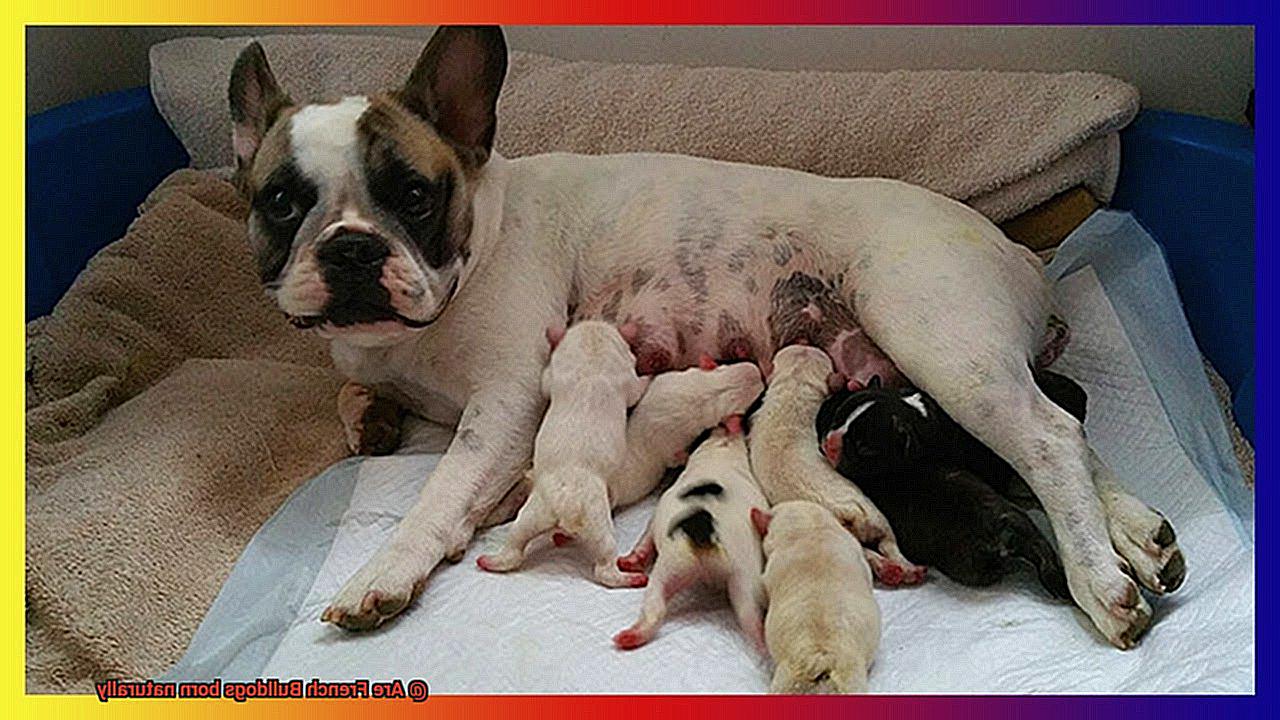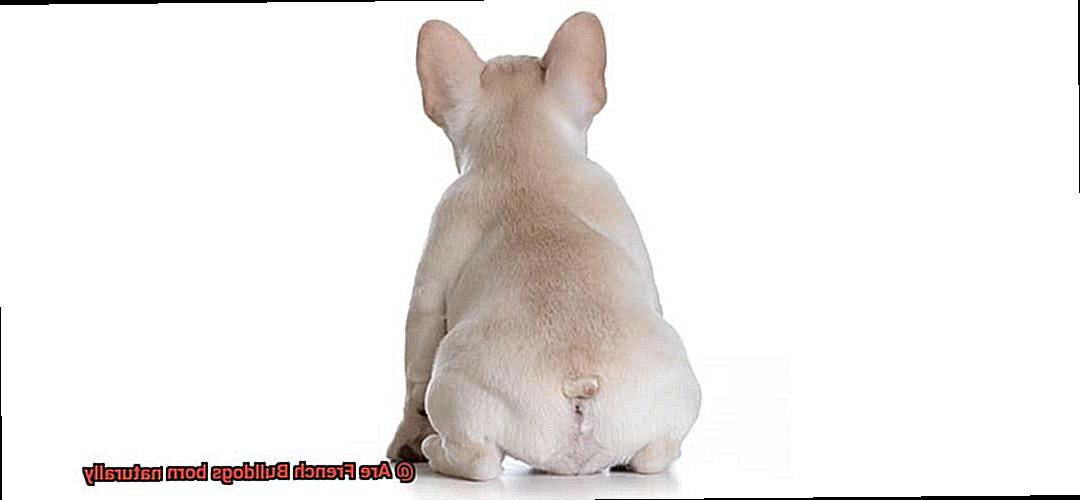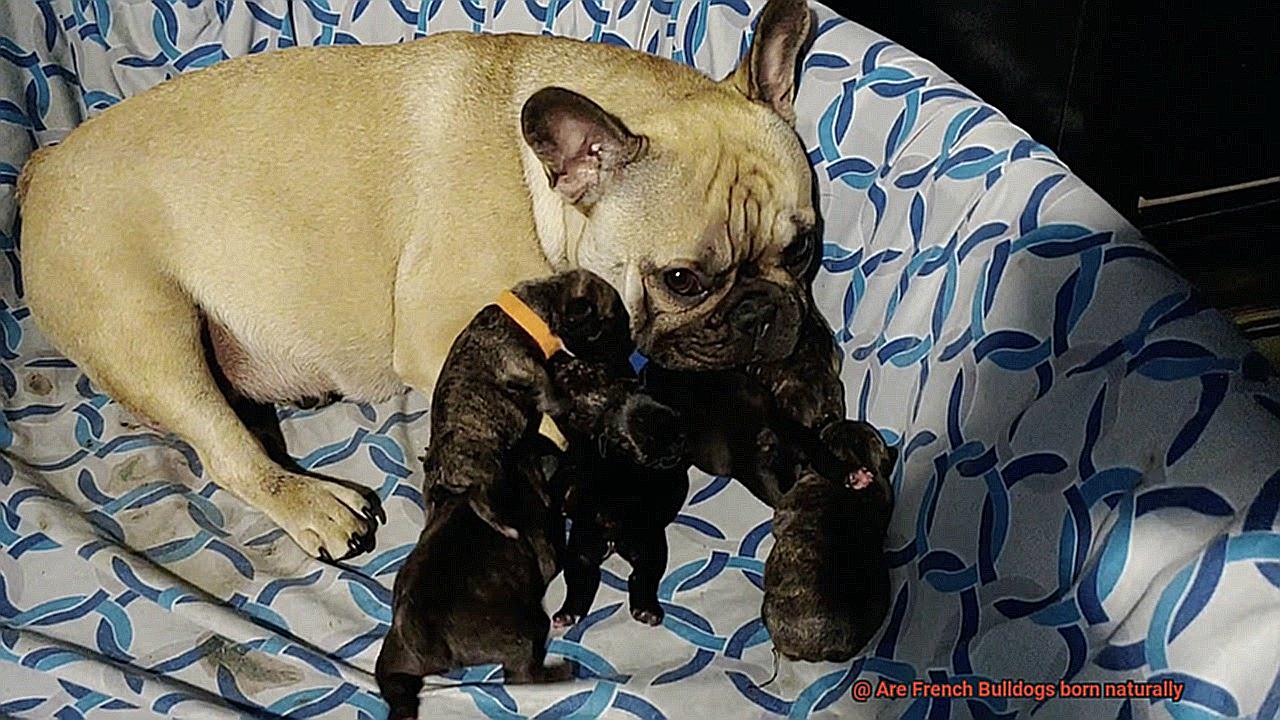Are French Bulldogs born naturally?
Today, we’re diving into the enchanting world of French Bulldogs and uncovering the truth about their birth process. French Bulldogs have stolen the hearts of dog lovers worldwide with their irresistible charm and unique looks.
But have you ever wondered how these adorable pups come into this world? Well, get ready for a fascinating journey as we explore the concept of natural breeding techniques specific to French Bulldogs.
So, grab a cup of your favorite brew, settle in, and let’s unveil the delightful secrets behind the natural birth of these precious fur babies.
The Unique Physical Characteristics of French Bulldogs
Contents
- 1 The Unique Physical Characteristics of French Bulldogs
- 2 Potential Risks and Complications Associated with Natural Births in French Bulldogs
- 3 Smaller Litters: An Advantage for French Bulldog Moms?
- 4 The Role of Breeding Practices and Veterinary Care in Natural Births for French Bulldogs
- 5 Alternatives to Natural Births for French Bulldogs: C-Sections
- 6 What to Expect When Your French Bulldog is Ready to Give Birth
- 7 Tips for Ensuring a Smooth Delivery for Your French Bulldog
- 8 Conclusion
French Bulldogs are undeniably one of the most lovable and recognizable dog breeds out there. Their unique physical characteristics make them stand out from the crowd and melt the hearts of dog enthusiasts worldwide. In this article, we will explore the delightful features that make French Bulldogs so special, along with some health implications associated with these traits.
Bat-Like Ears:
French Bulldogs are famous for their distinctive bat-like ears. These large, upright ears give them an adorable and comical expression, making them instantly recognizable. However, it is important to keep their ears clean and dry to prevent infections and irritations.
Short and Stocky Build:
With their compact body and muscular frame, French Bulldogs have a short and stocky build that adds to their charm. Their solid physique, broad chest, and strong legs make them appear sturdy, perfect for cuddling up on your lap or going on adventurous walks.
Wrinkled Face:
The deep wrinkles on a French Bulldog’s forehead give them a serious and thoughtful expression. While these wrinkles enhance their unique look, owners should take extra care to keep them clean to avoid skin infections or irritations.
Flat Face (Brachycephaly):
One of the most prominent features of French Bulldogs is their flat or pushed-in face, known as brachycephaly. This characteristic gives them their signature appearance but can lead to breathing difficulties, especially in hot or humid weather. Owners should be mindful of their Frenchie’s comfort and provide adequate cooling measures when necessary.
Expressive Eyes:
The expressive eyes of French Bulldogs are round, dark, and set wide apart. Their soulful gaze adds to their affectionate nature and irresistible charm. Regular eye check-ups are essential to ensure their eye health and detect any potential issues early on.
“Screw” Tail:
French Bulldogs have a short and straight tail that often curls up, resembling a corkscrew. This adorable tail wagging adds to their playful and joyful personality. However, it’s important to handle their tail with care to prevent any discomfort or injury.
Potential Risks and Complications Associated with Natural Births in French Bulldogs
French Bulldogs are beloved for their unique appearance and charming personality. However, their distinct physical characteristics, such as a shortened skull and flat face, can pose potential risks and complications during natural births.
In this article, we will explore the various challenges that French Bulldogs may face during labor and delivery, as well as the importance of informed decision-making for the health and safety of both the mother and her puppies.
Size and Shape of the Birth Canal:
French Bulldogs have a relatively narrow birth canal compared to other breeds. This can make it difficult for puppies with larger heads to pass through naturally, leading to prolonged labor or even obstructed labor. The mismatch in size between the puppies and the mother’s birth canal is a significant risk factor.
Respiratory Compromises:

Due to their brachycephalic nature, French Bulldogs are prone to respiratory issues. The strain of labor can put additional stress on their already compromised breathing, resulting in exhaustion and potential complications. Close monitoring of the mother’s breathing patterns is essential during natural births.
Risk of Dystocia:
Dystocia, or obstructed labor, is more common in French Bulldogs compared to other breeds. The unique anatomy of French Bulldogs, combined with their narrow birth canal, increases the risk of dystocia. This condition requires immediate veterinary attention to prevent harm to both the mother and the puppies.
Health Issues:
French Bulldogs are predisposed to certain health conditions that can complicate natural births. Hip dysplasia can make positioning for delivery challenging, while uterine inertia (a failure of the uterus to contract effectively) can hinder progress during labor.
High Cesarean Section Rate:
Due to these potential risks and complications associated with natural births in French Bulldogs, it is estimated that nearly 80% of French Bulldog litters are delivered via cesarean section. This surgical intervention is often recommended by veterinarians to ensure the safety of both the mother and her puppies.
Smaller Litters: An Advantage for French Bulldog Moms?
French Bulldogs, with their adorable looks and delightful personalities, may not have the easiest time when it comes to giving birth naturally. Their unique physical traits, like their squished faces and small pelvises, can make labor a challenging and risky process. In this article, we delve into the potential difficulties French Bulldogs face during delivery and emphasize the importance of making informed decisions for the well-being of both mother and puppies.
But did you know that French Bulldogs typically have smaller litters compared to other dog breeds? On average, they give birth to around 3-4 puppies per litter. This may seem like a disadvantage at first glance, but in fact, it can be seen as an advantage for French Bulldog moms in several ways.
Reduced Strain on the Mother’s Body
With fewer puppies to carry, the mother is less likely to experience complications such as excessive weight gain or difficulty in movement. Pregnancy can already be physically demanding for any dog, but the smaller litter size reduces the strain on the mother’s body, making it easier for her to carry and deliver her puppies.
Better Nutrition and Attention for Each Puppy
Smaller litters ensure that each puppy receives an adequate amount of nutrition and attention from the mother. With fewer siblings competing for resources, there is a higher chance for each puppy to thrive and grow properly. This can contribute to healthier and stronger puppies overall.
Individualized Care and Attention
French Bulldogs are known for their nurturing nature, and having a smaller number of puppies allows the mother to provide individualized care and attention to each one. From feeding to cleaning and socializing, the mother can focus on each puppy’s specific needs, which is crucial for their development.
Quality Over Quantity
Another advantage of smaller litters is that it allows breeders to focus on quality rather than quantity. With a limited number of puppies, breeders can dedicate more time and resources to ensure each puppy receives proper health screenings, vaccinations, and early socialization. This can contribute to raising well-adjusted and healthy French Bulldogs.
However, it’s important to note that smaller litter sizes also mean fewer puppies available for adoption. This can sometimes result in longer waiting lists or higher prices for those seeking to adopt a French Bulldog puppy. Responsible breeders prioritize the health of their dogs over quantity and take necessary steps to ensure healthy breeding practices.
In conclusion, the smaller litter size of French Bulldogs can be seen as an advantage for both the mother and the puppies. It reduces the physical strain on the mother during pregnancy, allows for individualized care and attention, and enables breeders to focus on quality rather than quantity. However, it’s important to approach breeding and adoption with responsibility and prioritize the health and well-being of these adorable and unique dogs.
The Role of Breeding Practices and Veterinary Care in Natural Births for French Bulldogs
French Bulldogs are adorable and beloved pets, but their unique physical characteristics can pose challenges during the birthing process. In this blog post, we will explore the importance of responsible breeding practices and proper veterinary care in promoting natural births for French Bulldogs.
Breeding Practices:
- Selection of Breeding Pairs: Breeders should carefully select breeding pairs based on their physical attributes, with particular attention to the size and shape of the pelvis. By choosing dogs with wider pelvises, breeders can help minimize the risk of complications during labor.
- Genetic Screening: It is crucial for breeders to conduct genetic screenings to identify any potential health issues that may affect the birthing process. This includes checking for conditions such as hip dysplasia, which can impact the size and shape of the pelvis.
- Maintaining a Healthy Weight: Proper nutrition and regular exercise are essential to keeping French Bulldogs at a healthy weight throughout pregnancy. Obesity can further hinder the birthing process, so breeders should provide a balanced diet and encourage appropriate exercise to prevent excessive weight gain.

Veterinary Care:
- Regular Check-ups: Regular veterinary care is vital for monitoring the health of both the mother and the developing puppies. Veterinarians can conduct ultrasounds and other diagnostic tests to assess the viability of the pregnancy and identify potential complications early on.
- Prenatal Care: Veterinarians can provide guidance on appropriate prenatal care, including vaccinations and supplements, to ensure the well-being of both the mother and her puppies.
- Cesarean Section Preparedness: Despite best efforts, natural birth may not always be possible for French Bulldogs. Breeders should be prepared with a plan for a safe cesarean section if necessary. Working closely with an experienced veterinarian is crucial to ensuring the best outcome for all involved.
Alternatives to Natural Births for French Bulldogs: C-Sections
French Bulldogs are undeniably cute and lovable, but their physical characteristics can pose challenges during childbirth. Their large heads and narrow hips make natural births difficult and potentially risky for both the mother and the puppies. In such cases, cesarean sections, or C-sections, can be a lifesaving alternative. In this article, we will explore the risks, benefits, and considerations of C-sections for French Bulldogs.
Risks of C-Sections:
- Anesthesia risks: French Bulldogs are known to have respiratory issues, making them more susceptible to anesthesia complications. It is crucial to have an experienced veterinarian who can handle these risks effectively.
- Infection: The surgical incision increases the risk of infection in both the mother and the puppies. Close monitoring and proper post-operative care are necessary to minimize this risk.
- Delayed bonding: Since C-sections involve immediate separation of the puppies from their mother, there may be a delay in bonding and establishing the maternal-infant relationship.
Benefits of C-Sections:
- Safer delivery: C-sections ensure a safer delivery by mitigating potential complications associated with natural births.
- Reduced stress: For French Bulldogs with obstructed labor or dystocia, C-sections provide a less stressful option for both the mother and the puppies.
- Improved survival rates: In cases where natural birth is not possible due to fetal distress or other complications, C-sections significantly increase the chances of survival for the puppies.
Considerations for C-Sections:
- Timing: Timely intervention is vital in cases where natural birth becomes unlikely or risky. Close monitoring during pregnancy allows for prompt decision-making regarding C-sections if needed.
- Skillful veterinary care: Engaging a skilled veterinarian experienced in performing C-sections on French Bulldogs is crucial to ensure the safety and well-being of the mother and the puppies.
- Financial implications: C-sections can be more expensive than natural births due to the surgical procedure, anesthesia, and additional care required.
Planned C-Sections:
In some cases, breeders may choose planned C-sections for their French Bulldogs, particularly if previous natural births have posed challenges. This allows for better planning and preparation, ensuring the best possible outcome for the mother and her puppies.
What to Expect When Your French Bulldog is Ready to Give Birth
It’s essential to understand what to expect when your French Bulldog is ready to give birth. In this article, we will cover the signs that indicate your Frenchie is approaching labor, as well as the stages of labor and what you can do to support her throughout the process.
Nesting Behavior: A Sign of Imminent Labor
As your French Bulldog’s due date approaches, you may notice her exhibiting nesting behavior. This includes scratching the floor or rearranging blankets and pillows to create a cozy nest for giving birth.
Decreased Appetite: Normal Before Labor
It’s common for a pregnant French Bulldog to have a decreased appetite as labor approaches. This is due to the limited space in her abdomen as the puppies grow. Monitor her closely for any signs of distress or complications during this time.
Restlessness and Anxiety: Signs of Labor
As labor nears, your Frenchie may become more restless and anxious. She may pace, pant, or seek comfort from you. Provide a calm and secure environment to ease her stress.
Contractions and Active Labor
Labor begins with strong contractions as your French Bulldog’s body prepares for delivery. Each puppy is typically born within 15-30 minutes of active pushing, but there can be variations in delivery times between puppies.
Potential Complications and When to Seek Help
While most French Bulldogs give birth without complications, it’s crucial to be prepared for potential issues. If your Frenchie experiences prolonged contractions without delivering a puppy or shows signs of distress, seek veterinary assistance immediately.
Post-Delivery Care

After each puppy is born, your French Bulldog will instinctively clean them. Ensure a quiet and peaceful environment for bonding and nursing. Monitor the puppies closely during their first few weeks of life to ensure their proper growth and health.
Tips for Ensuring a Smooth Delivery for Your French Bulldog
Bringing a litter of adorable French Bulldog puppies into the world is an exciting and rewarding experience. However, as a responsible owner, it is essential to be prepared and knowledgeable about the birthing process. In this guide, we will provide you with tips to ensure a smooth delivery for your French Bulldog.
Prioritize Prenatal Care:
Just like humans, proper prenatal care is crucial for the health of both the mother and her puppies. Regular visits to the veterinarian, a balanced diet, and appropriate exercise will help maintain a healthy weight and minimize complications during birth.
Prepare the Whelping Area:
Creating a comfortable and safe whelping area is essential for a stress-free delivery. Set up a quiet, warm, and secluded space away from distractions where your French Bulldog can give birth peacefully.
Recognize the Signs of Labor:
Familiarize yourself with the signs that indicate your French Bulldog is going into labor. Restlessness, nesting behavior, loss of appetite, and a decrease in body temperature are common signs that labor is imminent.
Have a Veterinarian on Standby:
Having a veterinarian on standby during the birthing process provides peace of mind. They can offer guidance and assistance if any complications arise. Remember, it’s always better to be safe than sorry.
Allow Natural Labor:
Mother dogs have innate instincts when it comes to delivering their puppies. Unless there is an emergency, it’s best to allow your French Bulldog to labor naturally without interference. Your calming presence will reassure her and help her stay relaxed.
Monitor Progress and Be Prepared for Complications:
Keep an eye on the progress of each puppy’s delivery. If more than two hours pass between puppies, contact your veterinarian as it could indicate a problem. Educate yourself on potential complications such as breech births or stalled labor, so you can act quickly and seek veterinary assistance if necessary.
LSzJWlWirwU” >
Conclusion
In conclusion, the unique physical characteristics of French Bulldogs make natural births a rarity. Their flat faces and narrow birth canals pose challenges for puppies during labor. This size mismatch often leads to prolonged or obstructed labor, respiratory compromises, and a higher risk of dystocia.
As a result, approximately 80% of French Bulldog litters are delivered via cesarean section. While C-sections come with their own risks and considerations, they provide a safer alternative for both the mother and her precious pups.
It’s worth noting that French Bulldogs typically have smaller litters compared to other breeds. While this may seem like a disadvantage at first glance, it actually offers several advantages. Smaller litter sizes reduce the physical strain on the mother’s body, allowing breeders to provide individualized care and attention to each puppy. It also enables breeders to prioritize quality over quantity.
Responsible breeding practices and proper veterinary care are crucial in promoting natural births for French Bulldogs. Breeders must carefully select breeding pairs based on physical attributes, conduct genetic screenings, and ensure healthy weights throughout pregnancy.
Regular check-ups and prenatal care from experienced veterinarians play vital roles in monitoring the health of both mother and puppies.




